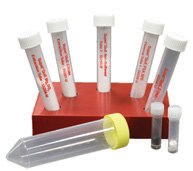QuEChERS Method for Pesticide Residue Analysis

Quenchers are used to diminish fluorescence intensity, thereby improving the detection of specific pesticides. In pesticide analysis, the quenching mechanism involves dynamic or collisional quenching. Here, the quencher and the pesticide molecule collide, causing energy transfer and reducing fluorescence intensity as a result. They minimize background fluorescence and unwanted signals that may interfere with accurate pesticide detection. This is particularly important in fluorescence-based detection methods, where the presence of quenchers can help improve the signal-to-noise ratio and the overall accuracy of the analysis.
QuEChERS significantly improves laboratory efficiency and throughput. This procedure requires only small quantities of solvent and can generate recoveries of 70-120% with RSDs <5% for a wide range of compounds.
The Quenching Process in Two Steps
1. Extraction
- Solvent extraction techniques are designed to achieve maximum yield of analytes from the base matrix.
- Solvent selection is important to minimize co-extracting compounds.
- Analytes are extracted from the matrix with acetonitrile and salts/buffers.
2. Cleanup
- Sample cleanup is necessary to reduce interferences.
- Interferences can damage analytical instrumentation and complicate analyte identification and quantification.
- The use of PSA, C18, GCB (Graphitized Carbon Black) or Z-Sep sorbents allow removal of sugars, lipids, sterols, organic acids, proteins, carotenoids, chlorophyll and other pigments prior to a GC-MS/MS or LC-MS/MS analysis.
- Homogenize sample
- Transfer sample to 50mL tube
- Add ACN and internal standard and shake for 1 min
- Extraction: Add extraction salts and centrifuge (55227-U for EN15662:2008 and 55234-U for 2007.01 AOAC)
- Cleanup: Transfer supernatant to cleanup tube
- Shake and centrifuge
a) LC-MS/MS Analysis: Dilute extract with mobile phase
b) GC-MS analysis: Analyze directly or after solvent exchange
The specific choice of quencher and its concentration will depend on the analytical method and the pesticides being targeted for detection.
Methods for Pesticide Analysis
EN 15662 QuEChERS Method
This method is a sample preparation technique used for the analysis of pesticide residues in food samples, including fruits, vegetables, and other food products.
AOAC 2007.01 QuEChERS Method
This method is used for the determination of pesticide residues in foods. Specifically, it is a multi-residue method for the analysis of over 300 pesticides and environmental contaminants in various food commodities.
QuEChERS Selection Guide
Products for the Extraction Step
Products for Cleanup (QuEChERS) Step
Method – EN15662:2008
Method – AOAC 2007.01
Specialty Products for Method EN15662 or AOAC 2007.01 – Alternatives
To continue reading please sign in or create an account.
Don't Have An Account?